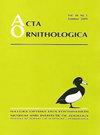大、小避难所的形成解释了日本列岛欧亚松鸦的形态分化
IF 1.3
4区 生物学
Q3 ORNITHOLOGY
引用次数: 0
摘要
摘要欧亚Jay Garulus glandarius是一种高度多型的鸟类,由34–36个亚种组成。冰川避难所的形成对产生其巨大多样性的进化过程的贡献尚未得到研究。我们研究了微避难所对日本列岛欧亚杰伊亚种分化过程的贡献。通过评估遗传多样性和重建线粒体系统发育树,我们询问外围岛屿(佐渡岛)的亚种与日本群岛大陆(本州和九州,以下简称大陆)的亚种的差异是否是通过在大陆大避难所外形成微避难所而发生的。我们还评估了佐渡岛和大陆松鸦种群之间的形态差异。我们测试了观察到的形态差异是否可以通过佐渡岛种群对一个物种贫乏的微避难所的适应来解释。基因分析推断,大约在中更新世晚期至更新世晚期,佐渡岛种群在大陆大型避难所外的避难所中生存。与大陆种群相比,佐渡岛松鸦种群的形态特征是性状变异较大,体型较大,喙过大。这些结果与物种多样性降低的微型避难所的预期形态进化模式一致。我们认为佐渡岛微型避难所的生态释放对日本列岛欧亚杰伊地理变异的演变具有重要意义。这是第一项评估微型避难所对欧亚杰伊多样化意义的研究。本文章由计算机程序翻译,如有差异,请以英文原文为准。
Formation of Macro- and Microrefugia Explains Morphological Divergence of the Eurasian Jay Garrulus glandarius in the Japanese Archipelago
Abstract. The Eurasian Jay Garrulus glandarius is a highly polytypic bird species composed of 34–36 subspecies. The contribution of formation of glacial refugia to the evolutionary process that generated its tremendous diversity has not been studied. We investigated the contribution of microrefugia to the subspeciation process of the Eurasian Jay in the Japanese archipelago. By assessing genetic diversity and reconstructing a mitochondrial phylogenetic tree, we asked whether divergence of a subspecies on a peripheral island (Sado Island) from the subspecies on the mainland of the Japanese archipelago (Honshu and Kyushu, hereafter mainland) occurred via formation of a microrefugium outside the mainland macrorefugia. We also assessed morphological differences between the Sado Island and mainland jay populations. We tested whether the observed morphological differences can be explained by adaptation of the Sado Island population to a species-poor microrefugium. Genetic analyses inferred that the Sado Island population survived in a refugium outside the mainland macrorefugia from around the late Middle to Late Pleistocene. The morphology of the Sado Island jay population was characterized by greater trait variance, larger body size, and a disproportionately large bill when compared with the mainland population. These results are consistent with the expected patterns of morphological evolution in microrefugia with reduced species diversity. We suggest the importance of ecological release in a microrefugium on Sado Island for the evolution of geographical variation of the Eurasian Jay in the Japanese archipelago. This is the first study to assess the significance of microrefugia for the diversification of the Eurasian Jay.
求助全文
通过发布文献求助,成功后即可免费获取论文全文。
去求助
来源期刊

Acta Ornithologica
生物-鸟类学
CiteScore
2.10
自引率
0.00%
发文量
14
审稿时长
>12 weeks
期刊介绍:
Publishes scientific papers (original research reports, reviews, short notes, etc.) and announcements from all fields of ornithology. All manuscripts are peer-reviewed.
Established in 1933 as Acta Ornithologica Musei Zoologici Polonici, since 1953 continued under the present title.
Published twice a year by the Natura Optima Dux Foundation under the auspices of the Museum and Institute of Zoology, Polish Academy of Sciences.
 求助内容:
求助内容: 应助结果提醒方式:
应助结果提醒方式:


